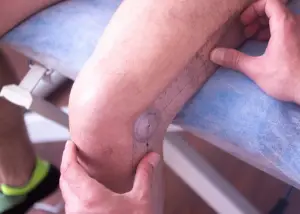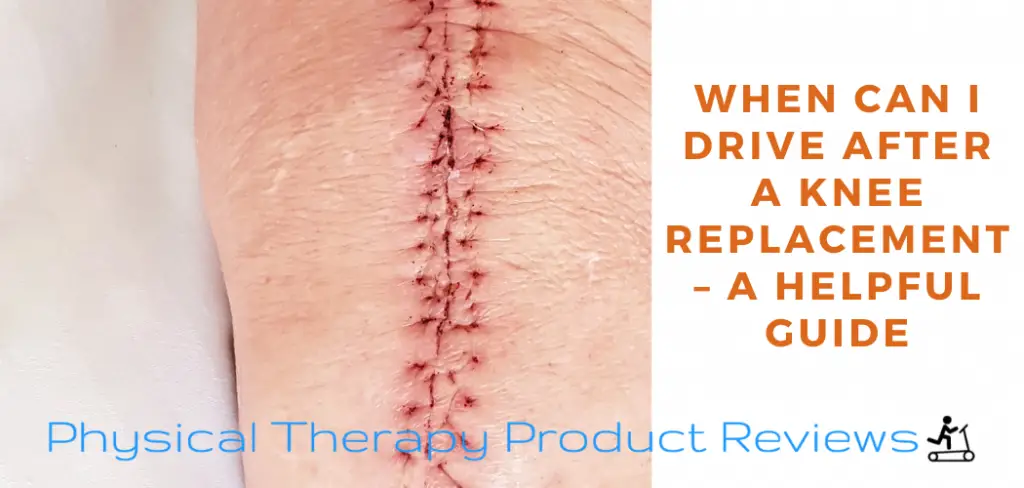One of the most common questions we get after a total knee replacement is, “when can I drive again?” Even though everyone heals at different rates, we can help you determine when it’s safe to drive after a knee replacement.
It also makes a difference whether you have a knee replacement on the right knee or the left knee. We’ve created a helpful table and shared some of our best tips to help you drive as soon as is safe after surgery.
Comparison Table of Driving with Left Vs. Right Knee Replacement
| Right Knee TKA | Left Knee TKA |
|---|---|
| Off pain meds | As soon as off pain meds |
| Knee flexion of 110 degrees | Need 90 degrees of flexion |
| Can quickly lift and push the leg without pain | Normal vitals and no lightheadedness with activity |
| Typically 3-4 weeks after surgery | Typically 1-3 weeks after surgery |
The Type of Car Matters
If all cars were the same size it would be a boring world and this post would be much shorter to write. Luckily, not all of our vehicles are the same, but some are definitely easier to get into than others. Some vehicles are easier than others to squeeze into.
Truck vs Car vs SUV After a Knee Replacement
A few important factors that make it easier to get into a vehicle after a knee replacement. This includes how far back the front seats can slide back to make it easier to bend your knee while you are getting into the car.
In general, SUV’s and trucks are easier to get into because there is more room to slide the front seats back and you don’t have to bend the knee as much to get to the lower seats of a car. However, some trucks can be hard to get into because of the height of the truck and stepping up into the truck.

Getting Into a Car After a Knee Replacement
Before you try and get into the car after a knee replacement it’s best to prepare.
- Park the car in an open space or next to the curb to have plenty of room to maneuver.
- Scoot the front seat as far back as it can go.
- It can even be beneficial to recline the seat during the first week after surgery to help give a little more room.
- Get as close as you can to the car using your walker or the crutches
- Turn around so that your back is facing the front seat and back up until you feel the seat touching the backside of the legs
- Be sure to use the seat and handle overhead; DON’T use the car door for support as it is unstable and will move
Slide back until your thighs are fully supported on the seat.
Once you are seated on the seat.
- Assist your legs into the car one at a time
- Use your hands to assist your legs as needed to get in and out comfortably
How to Get into the Car After a Knee Replacement

Automatic vs. Manual
You’ll be able to return to driving sooner in a car with an automatic transmission than one with a clutch or a manual transmission. Having to bend your knee to use a clutch will delay the timing by a few weeks. Plus, even getting into the vehicle and even lifting the leg over the clutch pedal is more complicated.
How to Know You Are Ready to Drive Again After a Knee Replacement
There are a few important milestones that you need to reach before you can begin driving after a knee replacement:
- You can no longer be taking narcotic pain medication for pain relief
- You have more than 80 degrees of knee flexion range of motion
- You have enough quad control to lift your leg into bed without using your hands. This signals that you have enough strength to shift pedals
Take a Test Drive First
We always recommend taking a short test drive around the neighborhood before trying to drive in town. Be sure to practice quickly changing the feet between the gas and brake pedals, slamming on the brakes (just in case it’s needed), and getting in and out of the car. Nothing is worse than driving to your destination and not being able to get out of the vehicle.
FAQ With Driving After a Knee Replacement
Do I have to wear compression stockings when driving?
Yes, this also depends on how long your surgeon wants you to wear your compression stockings but riding in the car for long distances is one of the higher risk activities for blood clots to occur. Some physicians require compression stockings to be worn for 2 weeks and some for 6 weeks.
Can I drive with my left leg after a knee replacement?
We recommend against it. Even though it may sound like a good idea, we know that some people do that already without knee replacements. It’s just not worth the risk. So instead, wait the extra week or two to be able to drive with the right leg.
How much range of motion do I need to get into a car?
We typically recommend that someone has at least 105 degrees of knee flexion to get into the driver’s seat of a car. This makes it easier to clear the pedals and slide into the front seat.

To get into the passenger seat, you need around 80-85 degrees of knee flexion to maneuver yourself into the front seat. Of course, this doesn’t mean it will be a comfortable ride at this range of motion, but you should be able to get into the car “normally.”
How much knee range of motion do I need to Drive a car?
Based on the research, you will need between 40-80 degrees of knee flexion on the right knee and 20-85 on the left knee to drive a car and switch your feet between the pedals. Getting into the vehicle may require more range of motion.
In Review
Being able to drive after a knee replacement can happen sooner than most people realize. If pain levels are under control, you have an adequate range of motion, and you are off pain medication, the freedom is yours to get back to normal driving activities.
Other Great Rehab Related Articles
GLP Weight Loss and Back Health: Effective Strategies and Insights
How to Stay Active After Cervical Fractures: Expert Tips and Advice
Dealing with Painful Stairs After Ankle Replacement Surgery
Walking After a Total Ankle Replacement: Tips for a Successful Recovery
Exercises While Non-Weight Bearing After Ankle Replacement: Elevation, AROM, Leg Raises, and More
Ankle Pain with Stairs: Causes and Home Treatment Options
Disclaimer: The information provided in this post is for educational purposes only. This is not a substitute for a medical appointment. Please refer to your physician before starting any exercise program.






